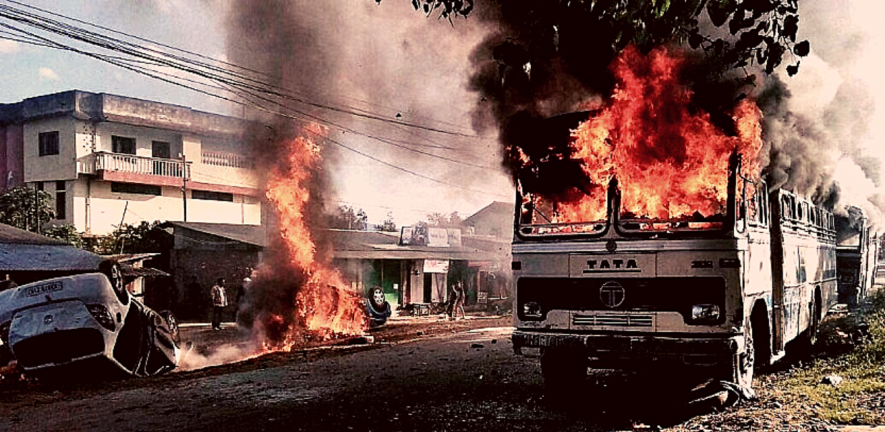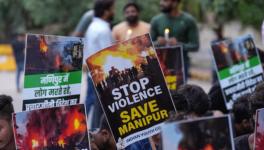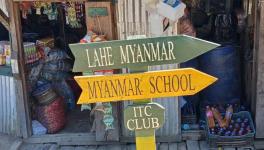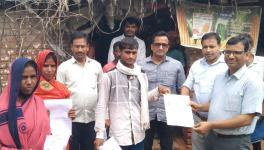Manipur Crisis: A Fresh Incision in Old Fissures

Representational Image.
Besides the Meitei community’s demand for inclusion in the list of the Scheduled Tribes, there has been a gradual build up of grievances that led to the recent agitation of tribal groups in Manipur.
—–
On Wednesday, violence ensued in the Bishnupur and Churachandpur districts of Manipur leading to destruction of homes, temples and churches that quickly escalated to other districts of the state over the following days. The violence followed the Tribal Solidarity March, organised by the All Tribal Student’s Union of Manipur (ATSUM), to protest against the demand of the Meitei community to be included in the list of Scheduled Tribes.
Reportedly, the Manipur High Court has issued notices to the chairman of the Hill Areas Committee and the president of ATSUM for appearance “for instigating innocent hill people”.
What are the criteria and the process for recognition of communities as Scheduled Tribes?
India’s Constitution recognises certain marginalised and disadvantaged tribal communities and entitles them to constitutional safeguards. State governments are given the responsibility for the inclusion and exclusion of tribal communities in the list of Scheduled Tribes.
Article 342 of the Constitution provides for the specification of tribes or tribal communities or groups or parts of or groups within tribal communities that are considered Scheduled Tribes in respect of a particular state or Union territory. According to Article 342(2), any amendment, or any inclusion or exclusion, to such a list of Scheduled Tribes can be made only by an Act of Parliament.
In 1999, the Union government approved ‘modalities’ to modify the list of Scheduled Tribes. These modalities were amended in 2002. The current procedure requires the concerned state or Union territory to propose and justify naming a new community as a Scheduled Tribe to the Union Ministry of Tribal Affairs.
If the ministry finds merit in the proposal, the proposal is sent to the Registrar General of India (RGI). Once approved by the RGI, the proposal is forwarded to the National Commission for Scheduled Tribes. After the concurrence of the authorities, it is sent to the Union cabinet for consideration of the amendment.
The Scheduled Tribes Demand Committee of Manipur has said that the Meiteis, who are included in the Other Backward Class category, were excluded from the Scheduled Tribe list without any constitutional safeguards, thereby marginalising them in their ancestral land. In opposition to their demands for inclusion, the United Naga Council has argued that the inclusion of Meiteis would defeat the purpose of the Scheduled Tribes list, which is to provide protective discrimination for groups that require it.
The current criteria that are followed for the specification of a community as a Scheduled Tribe include five indicators: i) primitive traits, ii) distinctive culture, iii) geographical isolation, iv) shyness of contact with the community at large, and v) backwardness.
Political influence, particularly the complex calculus of electoral politics, has played a role in shaping government policies and decisions in granting or denying Scheduled Tribe status to communities and groups. For example, the issue of Meitei communities inclusion in the Scheduled Tribes list was an election issue in the 2022 assembly elections in the state.
Why do Meiteis’ demand inclusion in the Scheduled Tribes list, and why is there tribal opposition to the demand?
Manipur consists of 34 recognised Scheduled Tribes, broadly falling under the Naga and Kukichin or Kuki tribal groups. The hills, inhabited by the tribals, amount to around 90 percent of Manipur’s total area whereas the Imphal valley, where the dominant Meitei community primarily resides, makes up the remaining 10 percent of the state’s area. The tribals are largely Christian, while the majority of Meiteis identify as Hindus.
Of the state’s projected population of 36.49 lakh in 2023 (28.56 lakh in the 2011 census), of whom about 53 percent are Meiteis, an estimated 70 percent are settled in the Imphal valley, and the remaining 30 percent live in areas that belong to the tribals.
The majority Meiteis inhabiting a mere 10 percent of the state’s landmass, coupled with their inability to buy land in the remaining 90 percent of tribal protected hill areas, which is declared as belonging Scheduled Tribes, has contributed to their demands to be included in the list of Scheduled Tribes.
The Scheduled Tribes Demand Committee of Manipur has said that the Meiteis, who are included in the Other Backward Class category, were excluded from the Scheduled Tribe list without providing them any constitutional safeguards, thereby marginalising them in their ancestral land. It has stated that their inclusion in the Scheduled Tribes category would ensure them equal right to land.
Meiteis have argued that they were listed as one of the tribes in Manipur before it merged with India in 1949. However, they were excluded when the Constitution (Scheduled Tribes) Order, 1950 was drafted, they claim.
The Meiteis’ demand for inclusion is opposed by the tribal community in the state on account of its apparent dominance in terms of population and political representation, with 40 of the 60 lawmakers in the state assembly belonging to the Meitei community.
In opposition to their demands for inclusion, the United Naga Council has argued that the Meitei community is an advanced community in India. According to it, the inclusion of Meiteis would defeat the purpose of the Scheduled Tribes list, which is to provide protective discrimination for groups that require it. Meitei community does not meet the criteria for inclusion, the United Naga Council has advocated.
How did a recent Manipur High Court order deal with the Meitei’s demand?
On April 19, the Manipur High Court directed the Manipur government to consider the inclusion of the Meitei community in the list of Scheduled Tribes and to send a recommendation to the Ministry of Tribal Affairs expeditiously, preferably within a period of four weeks.
The high court was hearing petitions that prayed for the inclusion of the Meitei community as a Scheduled Tribe in Manipur “to preserve the said community and save the ancestral land, tradition, culture and language”.
MLAs from tribal areas have been petitioning the state government for an appropriate negotiation on the issues. However, the negotiations never took place, causing BJP MLAs belonging to the Kuki community to withdraw their support from the state government.
The single judge of the high court, Acting Chief Justice M.V. Muralidaran, also highlighted that in 2013, the ministry had sent a letter to the Manipur government requesting consideration of the demand of the Meitei community for its inclusion in the list of Scheduled Tribes. However, the state government did not submit any recommendation to the ministry in the last ten years and could not provide any reasons for the delay, it remarked.
Reportedly, the high court order led to tensions between the Kuki tribe and the majority Meitei population in Manipur. The escalation of the tension to violence was seemingly caused when the ATSUM, comprising student leaders of the Kuki tribe, led a march against the Meitei community’s demand for inclusion.
The ATSUM had said that it was protesting against the “persistent demand of the Meitei community for inclusion in [Scheduled Tribe] category” and “the need for taking appropriate measures to collectively protect tribal interests”.
What is the larger context behind the protests?
According to an activist based in Manipur, who wished to remain anonymous, the demand of the Meitei community to be included in the list of Scheduled Tribes is “only the spark”, since there are other contributing factors that have led to the building up of grievances among tribal communities in Manipur.
Delving into such contributing factors, he explained that firstly, the eviction of many tribes or ‘forest dwellers’ from reserved forests areas, which was not undertaken for many years and is recently being done with rigour, has agitated tribal groups.
Secondly, the Bharatiya Janata Party (BJP)-led Manipur government’s recent withdrawal from the Suspension of Operations (SoO) arrangement with the Kuki National Army and the Zomi Revolutionary Army, two armed insurgent groups, has caused discontent, he highlights. The SoO arrangement, or a political negotiation, is a tripartite agreement among the Union government, the state government and the groups over establishing a ceasefire and availing of political dialogue to address the groups’ demands. The Union government is yet to agree to the withdrawal, he adds.
Thirdly, he pointed out that the tensions among the tribal groups is also caused on account of the state government’s drive to eliminate ‘illegal’ poppy cultivation, which the Kuki tribal community depends on. According to the tribal groups, the forest land belongs to them, since they are the traditional holders, he pointed out.
He emphasised that members of the legislative assembly (MLAs) from tribal areas have been petitioning the government for an appropriate negotiation on the issues. However, the negotiations never took place, causing agitation among the tribal MLAs. He also stated that despite belonging to the BJP, MLAs belonging to the Kuki community have withdrawn their support from the state government.
In view of these issues gradually building up over time, he remarked, “The march was only the spark, but the ammunition was being piled up over time”.
Sarah Thanawala is a staff writer at The Leaflet
Get the latest reports & analysis with people's perspective on Protests, movements & deep analytical videos, discussions of the current affairs in your Telegram app. Subscribe to NewsClick's Telegram channel & get Real-Time updates on stories, as they get published on our website.
























